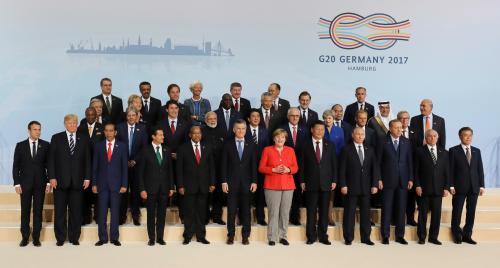Below is a viewpoint from Chapter 2 of the Foresight Africa 2018 report, which explores six overarching themes that provide opportunities for Africa to overcome its obstacles and spur inclusive growth. Read the full chapter on sustainable financing for African development here.
Structural features are driving Africa forward. Its demographics will dominate the global supply of young workers; its rural-urban transition will be at its peak, raising productivity; Chinese infrastructure is improving connectivity; and the fall in commodity prices forces diversification beyond natural resources. These changes open opportunities for investment. But Africa has been too complicated to attract much attention. Investing in Africa needs to get easier.
The G-20 Compact with Africa can bring change. Governments and agencies have recognized that Africa will develop through private investment. The G-20 has recognized that African governments themselves hold the key to breaking investor wariness of the continent. Preaching, cajoling, and paying African governments to say things they did not mean has changed to a menu of commitments that governments are free to make or ignore. The G-20 accepts that Africa, like Asia, will be led out of poverty by those governments that pioneer change. The compacts will help the most ambitious governments lead the way.
The G-20 accepts that Africa, like Asia, will be led out of poverty by those governments that pioneer change.
I have helped design this approach. Initially, a common reaction was that without money on the table, no African government would show interest. Now 10 governments are actively developing their own compacts. These plans combine practical detail and high-level commitment. For each, an integrated team of officials from the government and international agencies works on policy specifics clustered into three investor concerns: building a stable macroeconomic environment; providing a transparent and straightforward business environment; and deepening sources of investment finance. Governments choose their focus, and for each there is a further choice of suggested commitments. Once government commitments are determined, the complementary commitments that agencies and G-20 governments can make are negotiated. Again, there is no prior commitment for specific support, but there is a presumption of coherence.
These coherent packages of commitments will lower the costs and risks of investment. Since each process is driven by the government, no two compacts will look the same. But to be acceptable for the G-20, each must be credible, marking a quantum change to its chosen objective. High-level commitment from the G-20 has turned the new approach from a short-lived initiative into an enduring process: A standing committee will maintain momentum and provide continuity.
Over time, the new actions of the Compact with Africa governments, matched by complementary actions of supporting G-20 governments and the new investments that are attracted, will help change the realities on the ground. They will be tracked on www.CompactwithAfrica.org, administered by the IMF. As the compacts deliver, other governments will join. This is the lesson from Asia: Change happens not by reluctant governments being coerced, but as successful pioneers get emulated.







Commentary
Foresight Africa viewpoint – The G-20 Compact with Africa: African-driven programs
February 6, 2018